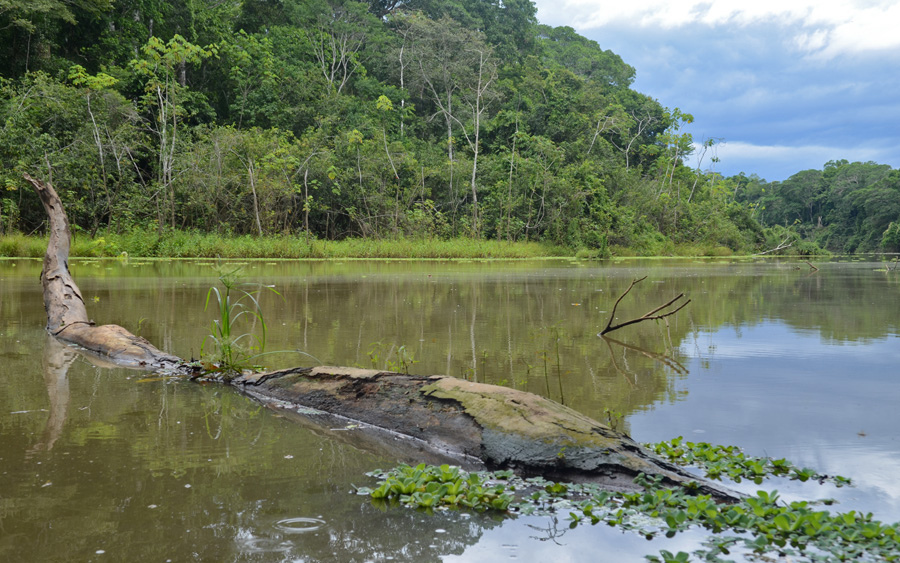
Los Amigos River in Madre de Dios. Photo © Geoff Gallice, licensed Creative Commons Attribution.
Your visit to Peru’s Amazon largely depends on the money you want to spend, the time you have, and what season you are traveling. If you only have 3–5 days and a few hundred dollars, look into lodges around Puerto Maldonado or Iquitos. If you have a week or more and a bigger budget, go to the Reserva de Biósfera del Manu or indulge yourself with a river cruise on the Amazon. There are exceptions to this rule, however. High levels of wildlife can also be found in the Reserva Nacional Pacaya Samiria, southwest of Iquitos, or the Reserva Nacional Tambopata, farther south of Puerto Maldonado. Either way, the best time to visit Peru’s jungle is during the dry months May–October, though Iquitos can be visited year-round. The Puerto Maldonado area, which is higher jungle, has an intense rainy season from January to April. Iquitos, which is much farther downstream, has more constant weather year-round.To figure out where to go, it helps to understand Peru’s different jungle zones. The jet stream in the southern hemisphere moves west, not east as in the northern hemisphere. Amazon humidity cools and condenses as it is forced over the eastern slopes of the Andes. This gives rise to the damp and chilly montane cloud forests perched between 700 and 2,900 meters of elevation. This is the habitat of the cock of the rock, a crimson, chicken-shaped bird; the Andean bear, the only surviving bear species of South America; and a huge range of colorful orchids, bromeliads, and hummingbirds. Peru’s most accessible montane cloud forests are around Tarapoto, Tingo María, Machu Picchu, and the drive into the Reserva de Biósfera del Manu.Lower down into the jungle, clear mountain streams cascade through steep mountain forests, giving way to broader, progressively muddier rivers that weave in through the increasingly flat landscape. This type of lowland rainforest occurs in Manu and Puerto Maldonado but reaches its greatest expression all the way downriver near Iquitos, where the Amazon reaches to be around two kilometers wide and the forest is perfectly flat.
The Reserva de Biósfera del Manu, which stretches from an altitude of 4,000 meters all the way down to 150 meters, protects one of the most pristine swaths of Peruvian Amazon, where a wide range of birds, primates, and mammals can be seen. The best time to visit is during the dry season May–November, though only sporadic rains occur starting November and December. There are only eight licensed tour operators in Manu, which charge between US$600 and US$2,250 for five- to nine-day tours ranging from beach camping to comfortable lodges. The Manu, like Puerto Maldonado, is in Peru’s southeastern jungle and is reached by a full-day bus ride or via flights into Boca Manu, a small airport.
The advantages of the lodges around Puerto Maldonado, downriver from Reserva de Biósfera del Manu, are cost and access: Travelers arrive within 30 minutes of flying from Cusco, and a two-night stay costs anywhere from US$60 to US$350. This area, on the edge of the Reserva Nacional Tambopata, has a good variety of monkeys, birds, caimans, and small mammals. As at Manu, the best time to visit here is May–November. There are levels of wildlife comparable to Manu at the Tambopata Research Center, a 7–10 hour boat ride from Puerto Maldonado. This center is next to the remote Parque Nacional Bahuaja Sonene and the world’s largest macaw clay lick or collpa.
The city of Iquitos, in Peru’s northeastern Amazon, forged Peru’s tourism industry back in the late 1960s but has grown so large that tourists have to go a long way to find interesting jungle. There is a wide variety of cost and quality in this area. If you don’t mind traveling a bit longer, some of Peru’s best lodges are upstream on the Marañón River, near the Reserva Nacional Pacaya Samiria, Peru’s largest protected rainforest area. Endangered wildlife such as the rare Amazonian manatee or sea cow can be observed here. Close to the Reserva Comunal Tamshiyacu Tahuayo, a reserve self-managed by the local communities, there are some good lodges. An hour by car from Iquitos, on the Iquitos–Nauta highway, is the Reserva Nacional Allpahuayo Mishana, the only protected white-sand forest, where new bird species have recently been discovered.
Unlike Puerto Maldonado, Iquitos can be visited year-round. The Puerto Maldonado area, which is higher jungle, has an intense rainy season from January to April. Iquitos, which is much farther downstream, has more constant weather year-round. Although the weather is relatively constant, the river rises 7–15 meters during the November–May rainy months in the Andes. During these months, the forests around Iquitos flood and soils are replenished with silt. Animals can most easily be spotted on the mud banks after the river drops, between June and September. The cost of Iquitos lodges ranges US$60–200 per night, depending on the distance from Iquitos.
There are interesting access points to the Peruvian high jungle or selva alta, including Chanchamayo Valley in Peru’s central jungle; Tingo María, a former drug trafficking zone that is rapidly becoming a safe and low-budget jungle destination with nearby Parque Nacional Tingo María; and Tarapoto, located upriver from Iquitos.
Excerpted from the Third Edition of Moon Peru.